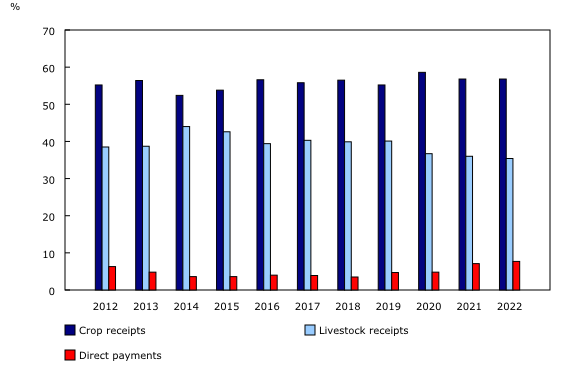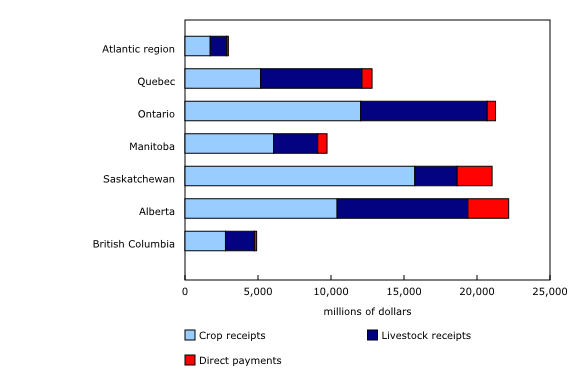Farm cash receipts, January to December, 2022
Released: 2023-02-28
$94.9 billion
January to December 2022
14.1% 
(year-over-year change)
Farm cash receipts totalled $94.9 billion in 2022, up 14.1% (+$11.7 billion) compared with 2021.
Crop receipts, livestock receipts and program payments all contributed to this increase.
All provinces had increases in farm cash receipts, led by Alberta (+$3.5 billion), Ontario (+$2.3 billion) and Saskatchewan (+$1.9 billion).
Higher crop prices more than offset the drop in marketings
Crop receipts rose by $6.7 billion (+14.1%) to $53.9 billion in 2022 from 2021. Higher farm cash receipts were a result of higher crop prices which more than offset the drop in marketings in many of the major crops. The drop in marketings in 2022 was the result of low beginning inventories for most major crops to start the calendar year, and despite better growing conditions relative to 2021 when drought negatively impacted crop production in Western Canada.
Farm cash receipts for wheat (except durum wheat) led the way with an increase of 28.2% to $9.2 billion. This was driven by a 42.0% increase in price, which occurred alongside a drop of 9.7% in marketings. This was also reflected in the international market as a lower quantity of wheat (except durum wheat) was exported but the value exported increased 21.9% due to high demand.
Canola also followed this trend as receipts increased by 13.4% to $13.7 billion on a rise of 38.9% in price and a drop of 18.4% in marketings.
Soybeans, which are mostly grown in eastern Canada, had receipts increase by 30.1% to $4.1 billion on increases of both marketings (+6.4%) and prices (+22.3%).
Durum wheat and flaxseed were the only major crops that had a drop in farm cash receipts.
Higher livestock prices lead to higher receipts
Livestock receipts increased by $3.6 billion (+12.1%) to $33.6 billion in 2022 compared with 2021.
Cattle receipts ($10.8 billion) accounted for just over 40% of the increase in livestock receipts. Although the number of cattle were fairly constant (+0.5%), the increase in prices (+14.0%) translated to higher receipts (+16.4%) for cattle. Cattle slaughter receipts increased by 15.4%, while cattle exports receipts were also positive.
Hog receipts increased by 4.4% from 2021 to $6.5 billion in 2022. Strong hog prices more than offset the lower number of hogs that were marketed for both slaughter and exports.
Supply managed receipts were up 12.8% to $14.1 billion and accounted for just over 40% of livestock receipts. All supply managed receipts were positive, with dairy receipts leading the way. Dairy receipts increased 11.4% to $8.2 billion, mainly as a result of an increase in price (+11.3%).
Crop insurance accounts for majority of program payments
Total direct payments rose by $1.4 billion (+23.6%) to $7.3 billion in 2022 as compared with the previous year. The 2021 drought in the Western provinces affected the amount and quality of crops that could be harvested at that time. Just over 80% of the program payments increase was a result of crop insurance (+$1.1 billion) and over 90% of these payments went to Alberta, Saskatchewan and Manitoba.
Note to readers
The next quarterly release of Farm Cash Receipts will occur on May 25, 2023, and will include data for January to March 2023.
Preliminary estimates of net farm income for 2022 will also be available on May 25, 2023.
All data in this release are in current dollars. Farm cash receipts measure the gross revenue of farm businesses. They include sales of crops and livestock products (except sales between farms in the same province) and program payments. Receipts are recorded when the money is paid to farmers. These do not represent their bottom line, since farmers have to pay their expenses and loans and cover depreciation.
Farm cash receipts are, for the most part, based on monthly marketings and the monthly prices of various commodities. Marketings are quantities sold, using various units of measure.
Data are extracted from administrative files and derived from other Statistics Canada surveys and/or other sources. These data are subject to revision. The COVID-19 pandemic has also had some impact on normal collection operations. For certain commodities, it was not possible to collect data either in time or at all; in these cases, estimates were produced (e.g., fur, maple syrup). Revisions to these estimates will be made in future releases as data become available.
To calculate exports, the Canadian International Merchandise Trade Web Application was used.
For the latest information on the Census of Agriculture, visit the Census of Agriculture portal.
For more information on agriculture and food, visit the Agriculture and Food Statistics portal.
As a result of the release of data from the 2021 Census of Agriculture on May 11, 2022, data on farm cash receipts, operating expenses, net income, capital value and other data are being revised, where necessary. The complete set of revisions will be released in the next 12 months.
Contact information
For more information, or to enquire about the concepts, methods or data quality of this release, contact us (toll-free 1-800-263-1136; 514-283-8300; infostats@statcan.gc.ca) or Media Relations (statcan.mediahotline-ligneinfomedias.statcan@statcan.gc.ca).
- Date modified:


